Pharmaceuticals, Vol. 17, Pages 1535: Corema album Berry Juice as a Protective Agent Against Neurodegeneration
Pharmaceuticals doi: 10.3390/ph17111535
Authors: Antonio Canoyra Carmen Martín-Cordero Dolores Muñoz-Mingarro Antonio J. León-González Richard B. Parsons Nuria Acero
Background/Objectives: Corema album berries are edible fruits from the Iberian Atlantic coast, characterized by a rich polyphenolic composition, which endows their juice with potential protective effects against neurodegeneration. This study aimed to evaluate the potential of the relatively lesser-known C. album berries as a novel neuroprotective agent against neurodegenerative diseases. Methods: The phenolic compounds of the juice were characterized using UHPLC-HRMS (Orbitrap). The SH-SY5Y neuroblastoma line was used to determine the preventive effect of the juice against H2O2-induced oxidative stress. Furthermore, neuronal cells were differentiated into dopaminergic and cholinergic lines and exposed to 6-hydroxydopamine and okadaic acid, respectively, to simulate in vitro models of Parkinson’s disease and Alzheimer’s disease. The ability of the juice to enhance neuronal viability under toxic conditions was examined. Additionally, its inhibitory effects on neuroprotective-related enzymes, including MAO-A and MAO-B, were assessed in vitro. Results: Phytochemical characterization reveals that 5-O-caffeoylquinic acid constitutes 80% of the total phenolic compounds. Higher concentrations of the juice effectively protected both differentiated and undifferentiated SH-SY5Y cells from H2O2-induced oxidative damage, reducing oxidative stress by approximately 20% and suggesting a dose-dependent mechanism. Moreover, the presence of the juice significantly enhanced the viability of dopaminergic and cholinergic cells exposed to neurotoxic agents. In vitro, the juice inhibited the activity of MAO-A (IC50 = 87.21 µg/mL) and MAO-B (IC50 = 56.50 µg/mL). Conclusions: While these findings highlight C. album berries as a promising neuroprotective agent, further research is required to elucidate its neuroprotective mechanisms in cell and animal models and, ultimately, in human trials.

 1 week ago
12
1 week ago
12


